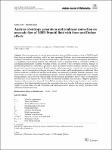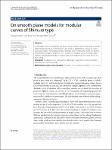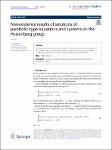Search
Author
- Carlos, Alegría (2)
- Carlos, Seara (2)
- David, Orden (2)
- Klaus, Bretterbauer (2)
- next >
Subject
Date issued
Has File(s)
- true (287)
Search Results
Pareto efficiency for robust linear programs was introduced by Iancu and Trichakis in [Manage Sci 60(1):130–147, 9]. We generalize their approach and theoretical results to robust optimization problems in Euclidean spaces with affine uncertainty. Additionally, we demonstrate the value of this approach in an exemplary manner in the area of robust semidefinite programming (SDP). In particular, we prove that computing a Pareto robustly optimal solution for a robust SDP is tractable and illustrate the benefit of such solutions at the example of the maximal eigenvalue problem. Furthermore, we modify the famous algorithm of Goemans and Williamson [Assoc Comput Mach 42(6):1115–1145, 8] in order to compute cuts for the robust max-cut problem that yield an improved approximation guarantee in... |
Here the assessment of entropy generation with Soret and Dufour impact in flow of MHD Prandtl fluid along an unsteady stretching surface has been measured. Nonlinear mixed convection and convective conditions for heat/mass transfer are imposed at the surface. The outcome of viscous dissipation and radiation is considered in heat transfer features. The obtained system of nonlinear PDEs is converted to ODEs by consuming dimensionless variables. Resulting systems are solved for the convergent solutions. Impacts of Prandtl fluid parameters, unsteadiness parameter, Soret and Dufour numbers, magnetic parameter, nonlinear thermal and concentration parameter, Prandtl number, radiation parameter, thermal and concentration Biot numbers, ratio of concentration to thermal buoyancy, Eckert numbe... |
In this paper we prove that there are finitely many modular curves that admit a smooth plane model. Moreover, if the degree of the model is greater than or equal to 19, no such curve exists. For modular curves of Shimura type we show that none can admit a smooth plane model of degree 5, 6 or 7. Further, if a modular curve of Shimura type admits a smooth plane model of degree 8 we show that it must be a twist of one of four curves. |
We introduce a persistent Hochschild homology framework for directed graphs. Hochschild homology groups of (path algebras of) directed graphs vanish in degree i≥2. To extend them to higher degrees, we introduce the notion of connectivity digraphs, and analyse two main examples; the first, arising from Atkin’s q-connectivity, and the second, here called n-path digraphs, generalising the classical notion of line graph. Based on a categorical setting for persistent homology, we propose a stable pipeline for computing persistent Hochschild homology groups. This pipeline is also amenable to other homology theories; for this reason, we complement our work with a survey on homology theories of directed graphs. |
In this paper, we shall assume that the ambient manifold is a pseudo-Riemannian space form Nm+1t(c)
of dimension m+1 and index t (m≥2 and 1≤t≤m). We shall study hypersurfaces Mmt′ which are polyharmonic of order r (briefly, r-harmonic), where r≥3 and either t′=t or t′=t−1. Let A denote the shape operator of Mmt′. Under the assumptions that Mmt′ is CMC and TrA2 is a constant, we shall obtain the general condition which determines that Mmt′ is r-harmonic. |
In this work, by the introduction of some parameters, a new half-discrete kernel function in the whole plane is defined, which involves both the homogeneous and the nonhomogeneous cases. By employing some techniques of real analysis, especially the method of a weight function, a new half-discrete Hilbert-type inequality with the new kernel function, as well as its equivalent Hardy-type inequalities are established. Moreover, it is proved that the constant factors of the newly obtained inequalities are the best possible. Finally, assigning special values to the parameters, some new half-discrete Hilbert-type inequalities with special kernels are presented at the end of the paper. |
In this paper, we present necessary conditions for the existence of weak solution of the parabolic-type equations and systems on the Heisenberg group. The main technique for proving the results relies on the method of test functions. |
This paper analyzes Bernardo Vittone’s self-invented room height method by translating it algebraically and comparing it with the arithmetic, geometric and harmonic means. The conclusion suggests that Vittone might have used the golden ratio to develop his room height method. |
We consider the stability analysis of a two-dimensional model for post-burn contraction. The model is based on morphoelasticity for permanent deformations and combined with a chemical-biological model that incorporates cellular densities, collagen density, and the concentration of chemoattractants. We formulate stability conditions depending on the decay rate of signaling molecules for both the continuous partial differential equations-based problem and the (semi-)discrete representation. We analyze the difference and convergence between the resulting spatial eigenvalues from the continuous and semi-discrete problems. |
The paradox of the plankton highlights the apparent contradiction between Gause’s law of competitive exclusion and the observed diversity of phytoplankton. It is well known that phytoplankton dynamics depend heavily on light availability. Here we treat light as a continuum of resources rather than a single resource by considering the visible light spectrum. We propose a spatially explicit reaction–diffusion–advection model to explore under what circumstance coexistence is possible from mathematical and biological perspectives. Furthermore, we provide biological context as to when coexistence is expected based on the degree of niche differentiation within the light spectrum and overall turbidity of the water. |










